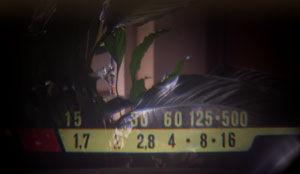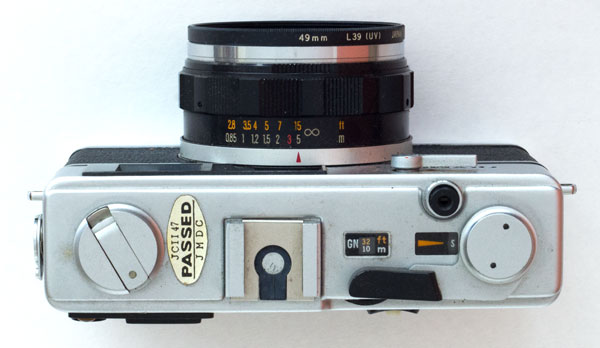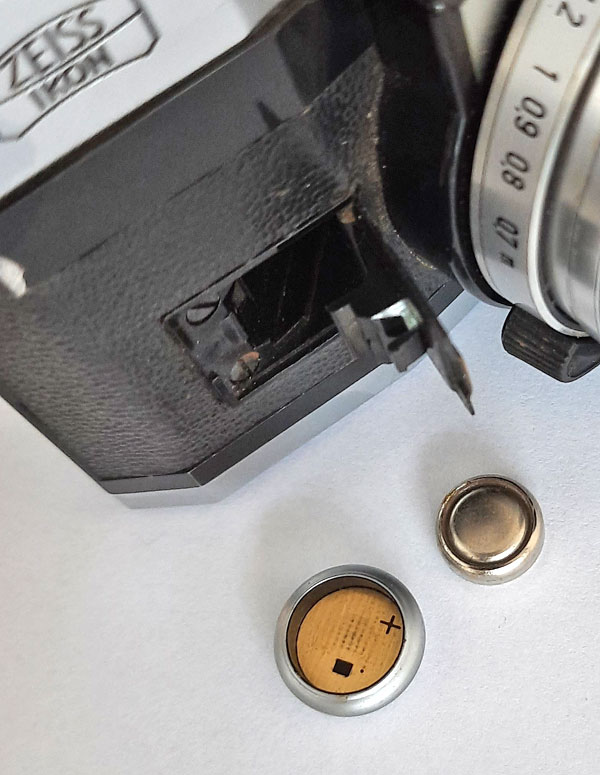Olympus 35DC | Olympus

– Olympus 35DC – Olympus – c.1970 –
Very special camera from Olympus. It only works in automatic exposure with camera selected combinations of speed and aperture! There is a gauge, visible in the viewfinder, and it goes from 1/15 at f1.7 (lowest light condition) to 1/500 at f16 (highest light condition). It locks on underexposure. You can lock the exposure of part of your scene with a half way pressure on the shutter release and then frame and shoot. Yes, it is a point and shoot with quite reasonable sophistication. But you will never get 1/500 at f1.7 for instance.
For focusing it has a very bright telemeter coupled with viewfinder. With a 6 elements Zuiko f 1.7 lens, the image quality is just excelent. Why such a nice lens in a camera with no manual or flexible automatic exposure ? Relax, take pictures with it and you will like them. Below, how the pairs aperture/speed are seen in the viewfinder.

The hot shoe allows the usage of flash in a particular way also: you tell the camera what is the guide number of your flash unit and, as you focus your subject, the aperture is set according to the distance. Below, we see the GN (guide number) setting on top of camera body.

The battery issue
The only downside is that it was designed for older mercury oxide batteries like the MR9, PX13 and PX625 among many other appellations of the time. They had a voltage of 1.35 V, but they stopped being manufactured a long time ago for environmental reasons as mercury is very toxic.
A replacement idea that appears frequently on photo forums is to use 1.5V alkaline batteries. The LR9 (PX625A) has exactly the same size: diameter, 15.6 mm, height 5.95 mm, and physically fits perfectly in the camera compartment.
People think that from 1.35 to 1.5V the difference in camera reading can be compensated for with a simple calibration, for example, setting an ISO in the camera such that the exposure is correct compared to a photometer known and well calibrated.
But that’s not the point. This procedure can even work, but the point is that the great advantage of mercury batteries is not the value of the 1.35V voltage they provide, but rather the permanence of this voltage throughout the lifetime of the battery. This is no longer the case for alkalines. An alkaline battery starts its useful life with 1.5V and with use this voltage drops constantly until it becomes useless for the application for which it is intended.
The strategy of calibrating the camera to 1.5V would have to be applied each time the alkaline voltage drops to a new level. You would need to constantly calibrate and that’s not practical.
The definitive solution is to use an adapter that, through micro electronic components, manages to receive a higher voltage and always automatically deliver the 1.35 for which the camera’s photometer was designed and calibrated.

These adapters are like little pans that have a 1.55V battery inside so that the external dimensions are exactly like the original mercury batteries. Above we see the adapter, a 386 battery and the compartment of the Contaflex Super BC. These adapters are expensive, but they solve the problem once and for all. To see the options, search for MR-9 adapter.
I bought mine at Small Battery Company. It runs with 386 silver oxide batteries, which are easy to find. On the MR-9 page they give more information about it. An important point, for example, is that the adapter only works when the current required is very low, something like 200 micro amps. This is not a big problem because obviously the manufacturers of cameras and light meters managed to size their devices to use the least amount of current possible and thus prolong battery life. The only exceptions cited in Small Battery Company are Canonet GIII 17 and 19. I use it with Olympus OM1n, Contaflex Super BC, Canon Pellix, Canon FT and have never had any problems.
There is also a WeinCell MRB625 battery, which can also replace the old PX625. This is a zinc/air battery that was designed to replace mercury oxide ones. But it has a higher price than the silver oxide 386 and is not so easy to find. I think the adapter is still the ideal solution.
Having overcome this crucial battery issue on the Olympus 35DC, which only works on automatic, I would say that for those looking for flexibility and don’t want to have to adjust everything before taking the picture, this is/was still a great option for a second camera, for those moments when all you want is lightness, simplicity and quality to take some snapshots.
Some pictures taken with it.








Hello,
Do you have to have a battery in the camera in order to load and advance film?
Thanks
I was looking for my battery adapter and could not find it. So I was not able to make a proper test. What I know is that the camera does not fire without battery. As it has also a double exposure protection, chances are that by acting the shutter release, although it does not fire, it may lock the film advance lever. My camera, without battery is not advancing the film. But I could not check the condition “with battery”, maybe it has something else broken. It is in excelente looking condition but last time I used it was more than 15 years ago. Sorry for not being able to be more positive.
I agree with your comments about the DC. I have shot one for a while and been impressed with results. With more interest in film now these rangefinders are becoming quite expensive. But when you consider these cameras are 50 years old and mostly still working – more than can be said for most digitals of today.
did you use flash taking those photos?
No, no flash, all taken with available light only
Are there are any brands or links that your recommend for the batteries?